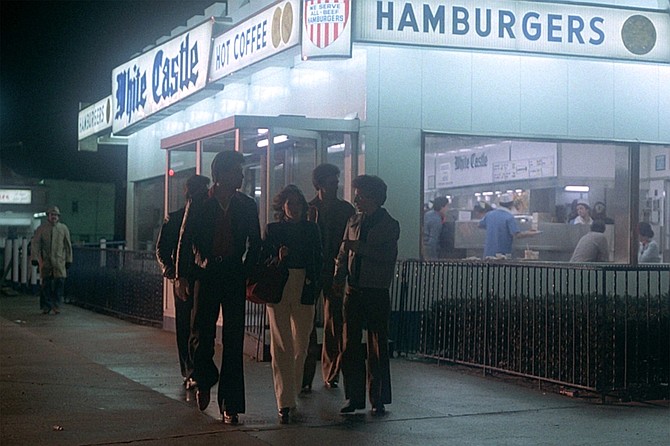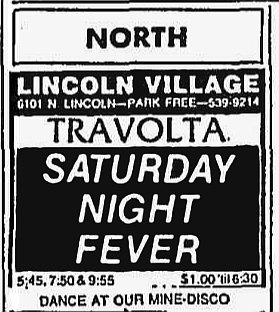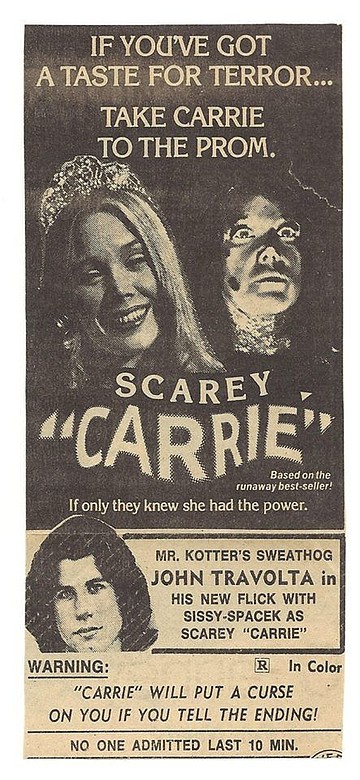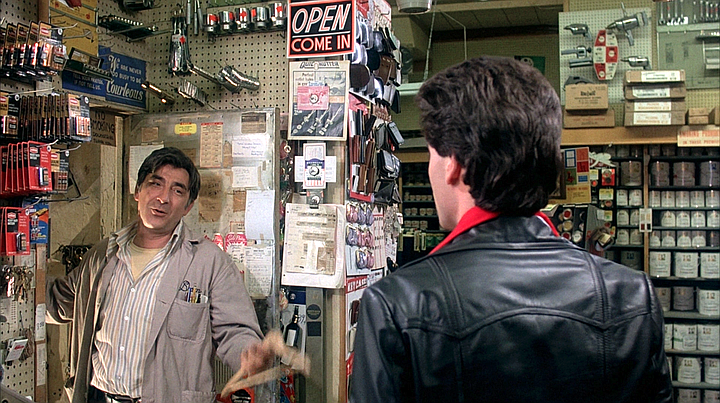 Facebook
Facebook
 X
X
 Instagram
Instagram
 TikTok
TikTok
 Youtube
Youtube

Saturday Night Fever made something special out of white polyester and blow-dryers as an extension of one’s arm, and transformed Deney Terrio — John Travolta’s trainer and future host of Dance Fever — into a household name.
Saturday Night Fever (1977)
John Travolta was responsible for spearheading not one but two culture-crippling trends — disco and the mechanical bull — and legendary Chicago showman Oscar Brotman cashed in on both. When it came time for Saturday Night Fever to hit the screen of his Lincoln Village Theatre, rather than dismissing disco as a developmental disconnect, Brotman embraced the craze by transforming a portion of the theatre’s spacious lobby into a mini-disco (or a watch-where-you-step “mine-disco,” as the newspaper ad suggested at the time), a giant Lite Brite box located to the right of the concession stand. (Years later, a bucking machine was erected on the same spot to celebrate the opening of Urban Cowboy.) Further, a giant likeness of Travolta painted on the side of the building seemed to stretch to the sky.

Adding to the disco delirium, Brotman raided the Fred Astaire Studio and hired pros to prance delightedly on stage before each show and during intermission. A brace of Tony Manero wannabes in attendance that opening night pelted the entertainers with a steady stream of discouraging heckles. But like bossman Astaire, the duo’s smiles and fluid moves remained undithered. No one expected a film about a short-lived fad to have such staying power, but this is one that gets better with time.
Had it not been for the film, and the $285 million it took in, disco would have been dead by 1977. We open memorably on a paint run through the streets of Brooklyn that invites audiences to follow the bouncing can rhythmically dangling from store clerk Tony Manero’s (Travolta) hand. Travolta oozes seductiveness, so much so that it’s almost easy to overlook the more repugnant aspects of his personality: Tony’s joke about a customer’s wife’s ass finds the shnook on the receiving end of the gag laughing and patting him on the shoulder on his way out the door.
Paramount had no faith in the production. The suits considered it a “vulgar little movie” with little to redeem it. As if chain-smoking weren’t enough to earn the film its R rating, Manero is a confirmed sexist, racist, and gay-basher who resorts to attempted rape when he doesn’t get his way. And yet screenwriter Norman Wexler’s dialogue remains as fresh as the day it was written. Travolta fought hard not to sweeten Tony, and if there’s one thing on which to pin the film’s success, it’s the entirely fair approach it takes to the characters. More than dance, this unblinking view of unlikable characters accounts for the film’s enormous staying power.

John Avildsen was originally set to direct. The VH1 Behind the Music documentary on the DVD Extras finds producer Robert Stigwood blaming Avildsen’s departure on the director’s receiving an Oscar nomination for Rocky. (The Rocky poster that adorns Tony’s wall may be viewed as an olive branch.) Even though The Bingo Long Traveling All-Stars & Motor Kings was the only film to John Badham’s credit, the director got the call from Stigwood, and two days later was on his way to New York. And while Travolta had played a bit role in Carrie, prior to Fever, he was best known as the Sweathog in the plastic bubble. All things considered, the relative neophyte packed a great deal of creative clout on the set: many of the actor’s improvisations made their way into the final cut. (The “watch the hair” ad-lib was a sincere effort on Travolta’s part to get Val Bisoglio, the actor playing his father, to stop messing up what took hours to create.) Travolta even complained to Stigwood about Badham’s close-up coverage of the climactic number, and the producer agreed, awarding Travolta final cut over the director and editor.
The term “dansical” — a musical without singing — was a new one on me, but the genre fits. The “Night Fever” number offers a welcome respite from the reality that engulfs it. Tony glides into the disco, where, as if on cue, two girls await at the foot of the stairs, each poised to take him by the hand. This spontaneously staged moment morphs into a smoke-filled fantasy world that in no time has a line dance snaking through it.
Audiences loved it, but in the eyes of the studio, there was lots more money to be made by tapping into the youth market. Back in the day, films looking to play major networks would cover certain scenes twice to sweeten the more objectionable dialogue. (The Raging Bull blu-ray includes a sanitized CBS version that’s well worth your time.) Paramount went on to edit six minutes out of the original film, giving it a PG rating for a 1979 reissue. I can’t think of another example of what’s basically an airline print earning a theatrical release.
They might be the same age, but Bobby C. (Barry Miller) would give anything to be like Tony when he grows up. This desperate attempt to borrow a cup of Sal Mineo from Rebel Without a Cause is the film’s one big misstep. Bobby is such a whiny drip, one questions whether he is really engaged or if his pregnant bride-to-be is a delusion. (We never see Pauline.) According to Badham, “They let Barry Miller make the dialogue his own.” Except for one slip-up involving a maudlin conversation between Tony’s brother Frank (Martin Shaker) and Bobby at the bar, Wexler’s script honor’s Tony’s point-of-view. Apart from that one moment, Tony appears in every scene. As for Frank, back living with his parents after resigning from the priesthood, it seems he had long lost his calling. The little belief left in him stemmed from buying into his parent’s bragging rights to having a priest for a kid. There’s a side of Tony that’s happy his brother is no longer the #1 son: his leaving the Church evens the score a bit, or as Tony says, “If you ain’t so good, I ain’t so bad.”

The biggest risk was the casting of unknown Karen Lynn Gorney as Tony’s love interest, Stephanie. Though nine years Travolta’s senior in real life, Gorney is called upon to play a character just one year older than Tony. Apparently, audiences of the day were unwilling to buy into a May-December romance. Tony is like Elvis: girls from blocks around bring their handkerchiefs to dab his sweat. Always the prettiest boy on the dance floor, Tony is not the “if you can get into my head, you can get into my bed” type. No matter how good a partner a gal is on the dance floor, when it comes to loving, it’s all about looks — something the too-eager Annette (Donna Pescow) comes up short on in Tony’s estimation. Farrah-feathered Annette waits outside in the cold rather than stand inside the warm dance studio, because she likes to watch Tony walk. Tony laughs it off, yet he doesn’t possess the empathy needed to put his arm around Stephanie when she breaks down.
We’ll close with a cherished anecdote that was confirmed by the man who originated it: Roger Ebert, while in town for the 2006 Country Fair. His critical better-half and Saturday Night Fever groupie Gene Siskel bought Travolta’s iconic white suit at a charity auction. Upon learning this, Ebert quipped, “Anyone who would pay $2000 for John Travolta’s suit from Saturday Night Fever has snot for brains.”


Saturday Night Fever made something special out of white polyester and blow-dryers as an extension of one’s arm, and transformed Deney Terrio — John Travolta’s trainer and future host of Dance Fever — into a household name.
Saturday Night Fever (1977)
John Travolta was responsible for spearheading not one but two culture-crippling trends — disco and the mechanical bull — and legendary Chicago showman Oscar Brotman cashed in on both. When it came time for Saturday Night Fever to hit the screen of his Lincoln Village Theatre, rather than dismissing disco as a developmental disconnect, Brotman embraced the craze by transforming a portion of the theatre’s spacious lobby into a mini-disco (or a watch-where-you-step “mine-disco,” as the newspaper ad suggested at the time), a giant Lite Brite box located to the right of the concession stand. (Years later, a bucking machine was erected on the same spot to celebrate the opening of Urban Cowboy.) Further, a giant likeness of Travolta painted on the side of the building seemed to stretch to the sky.

Adding to the disco delirium, Brotman raided the Fred Astaire Studio and hired pros to prance delightedly on stage before each show and during intermission. A brace of Tony Manero wannabes in attendance that opening night pelted the entertainers with a steady stream of discouraging heckles. But like bossman Astaire, the duo’s smiles and fluid moves remained undithered. No one expected a film about a short-lived fad to have such staying power, but this is one that gets better with time.
Had it not been for the film, and the $285 million it took in, disco would have been dead by 1977. We open memorably on a paint run through the streets of Brooklyn that invites audiences to follow the bouncing can rhythmically dangling from store clerk Tony Manero’s (Travolta) hand. Travolta oozes seductiveness, so much so that it’s almost easy to overlook the more repugnant aspects of his personality: Tony’s joke about a customer’s wife’s ass finds the shnook on the receiving end of the gag laughing and patting him on the shoulder on his way out the door.
Paramount had no faith in the production. The suits considered it a “vulgar little movie” with little to redeem it. As if chain-smoking weren’t enough to earn the film its R rating, Manero is a confirmed sexist, racist, and gay-basher who resorts to attempted rape when he doesn’t get his way. And yet screenwriter Norman Wexler’s dialogue remains as fresh as the day it was written. Travolta fought hard not to sweeten Tony, and if there’s one thing on which to pin the film’s success, it’s the entirely fair approach it takes to the characters. More than dance, this unblinking view of unlikable characters accounts for the film’s enormous staying power.

John Avildsen was originally set to direct. The VH1 Behind the Music documentary on the DVD Extras finds producer Robert Stigwood blaming Avildsen’s departure on the director’s receiving an Oscar nomination for Rocky. (The Rocky poster that adorns Tony’s wall may be viewed as an olive branch.) Even though The Bingo Long Traveling All-Stars & Motor Kings was the only film to John Badham’s credit, the director got the call from Stigwood, and two days later was on his way to New York. And while Travolta had played a bit role in Carrie, prior to Fever, he was best known as the Sweathog in the plastic bubble. All things considered, the relative neophyte packed a great deal of creative clout on the set: many of the actor’s improvisations made their way into the final cut. (The “watch the hair” ad-lib was a sincere effort on Travolta’s part to get Val Bisoglio, the actor playing his father, to stop messing up what took hours to create.) Travolta even complained to Stigwood about Badham’s close-up coverage of the climactic number, and the producer agreed, awarding Travolta final cut over the director and editor.
The term “dansical” — a musical without singing — was a new one on me, but the genre fits. The “Night Fever” number offers a welcome respite from the reality that engulfs it. Tony glides into the disco, where, as if on cue, two girls await at the foot of the stairs, each poised to take him by the hand. This spontaneously staged moment morphs into a smoke-filled fantasy world that in no time has a line dance snaking through it.
Audiences loved it, but in the eyes of the studio, there was lots more money to be made by tapping into the youth market. Back in the day, films looking to play major networks would cover certain scenes twice to sweeten the more objectionable dialogue. (The Raging Bull blu-ray includes a sanitized CBS version that’s well worth your time.) Paramount went on to edit six minutes out of the original film, giving it a PG rating for a 1979 reissue. I can’t think of another example of what’s basically an airline print earning a theatrical release.
They might be the same age, but Bobby C. (Barry Miller) would give anything to be like Tony when he grows up. This desperate attempt to borrow a cup of Sal Mineo from Rebel Without a Cause is the film’s one big misstep. Bobby is such a whiny drip, one questions whether he is really engaged or if his pregnant bride-to-be is a delusion. (We never see Pauline.) According to Badham, “They let Barry Miller make the dialogue his own.” Except for one slip-up involving a maudlin conversation between Tony’s brother Frank (Martin Shaker) and Bobby at the bar, Wexler’s script honor’s Tony’s point-of-view. Apart from that one moment, Tony appears in every scene. As for Frank, back living with his parents after resigning from the priesthood, it seems he had long lost his calling. The little belief left in him stemmed from buying into his parent’s bragging rights to having a priest for a kid. There’s a side of Tony that’s happy his brother is no longer the #1 son: his leaving the Church evens the score a bit, or as Tony says, “If you ain’t so good, I ain’t so bad.”

The biggest risk was the casting of unknown Karen Lynn Gorney as Tony’s love interest, Stephanie. Though nine years Travolta’s senior in real life, Gorney is called upon to play a character just one year older than Tony. Apparently, audiences of the day were unwilling to buy into a May-December romance. Tony is like Elvis: girls from blocks around bring their handkerchiefs to dab his sweat. Always the prettiest boy on the dance floor, Tony is not the “if you can get into my head, you can get into my bed” type. No matter how good a partner a gal is on the dance floor, when it comes to loving, it’s all about looks — something the too-eager Annette (Donna Pescow) comes up short on in Tony’s estimation. Farrah-feathered Annette waits outside in the cold rather than stand inside the warm dance studio, because she likes to watch Tony walk. Tony laughs it off, yet he doesn’t possess the empathy needed to put his arm around Stephanie when she breaks down.
We’ll close with a cherished anecdote that was confirmed by the man who originated it: Roger Ebert, while in town for the 2006 Country Fair. His critical better-half and Saturday Night Fever groupie Gene Siskel bought Travolta’s iconic white suit at a charity auction. Upon learning this, Ebert quipped, “Anyone who would pay $2000 for John Travolta’s suit from Saturday Night Fever has snot for brains.”
Comments